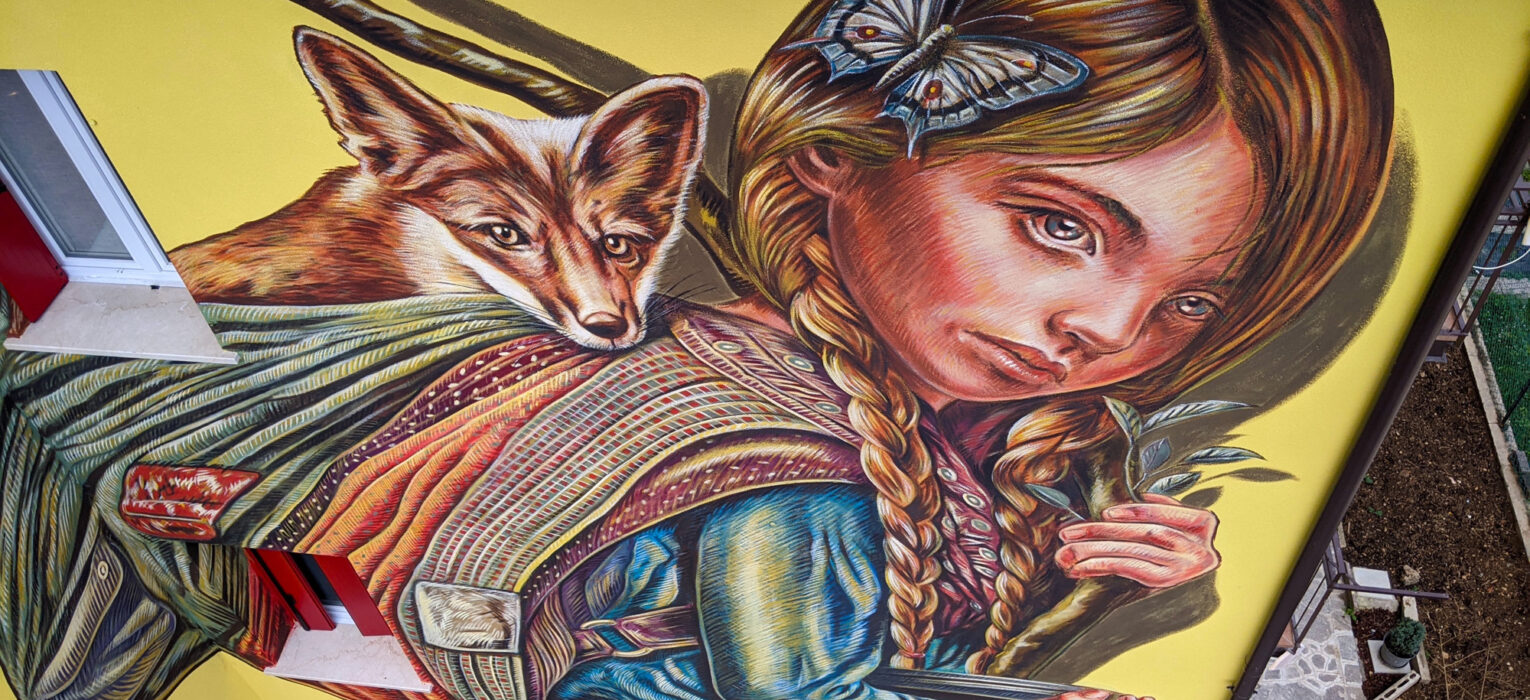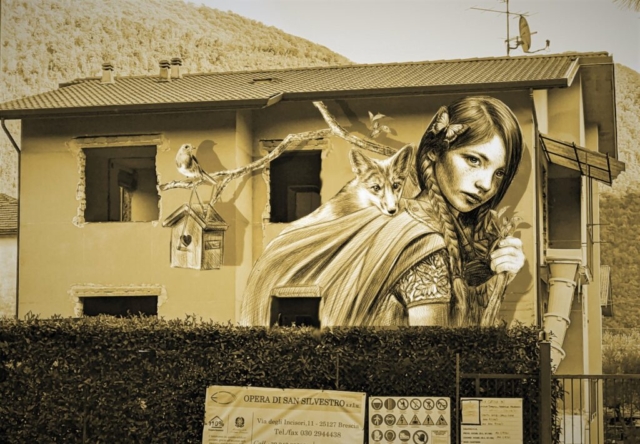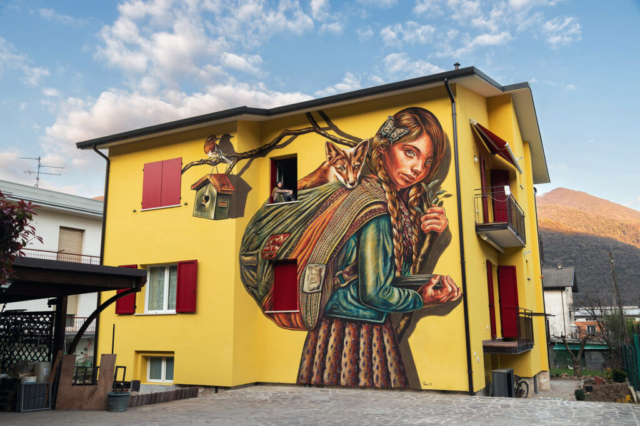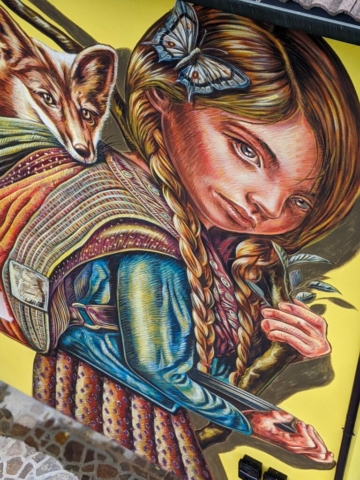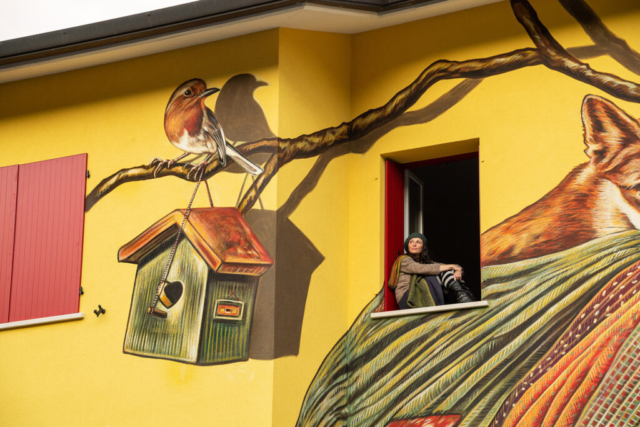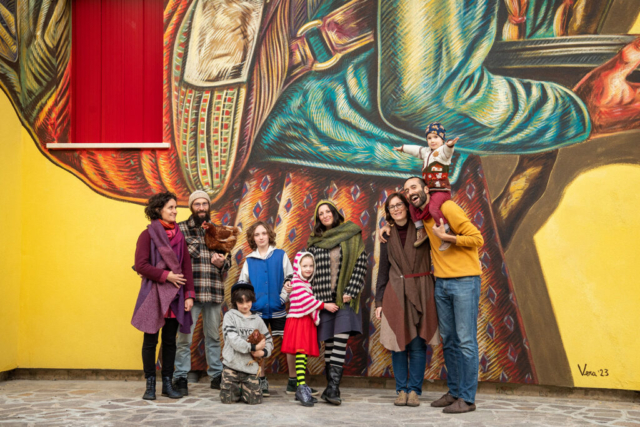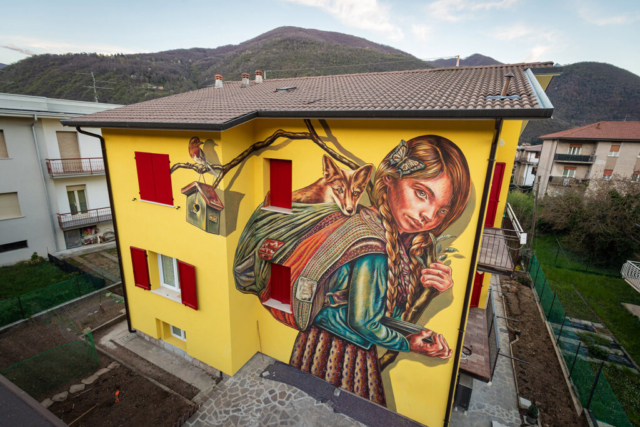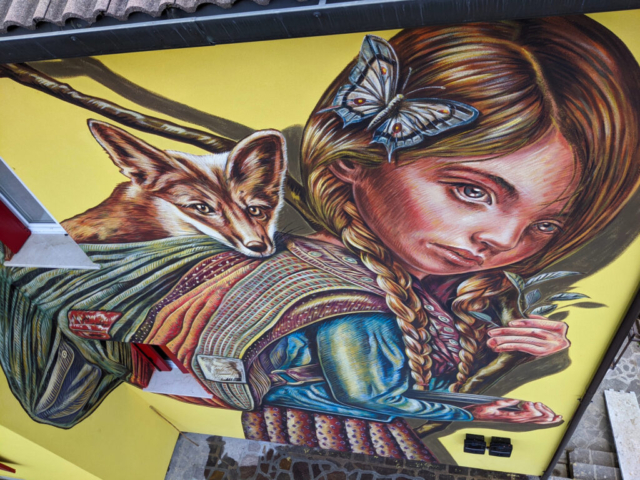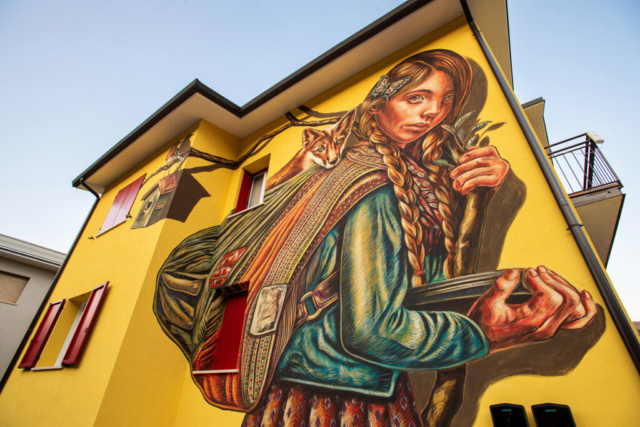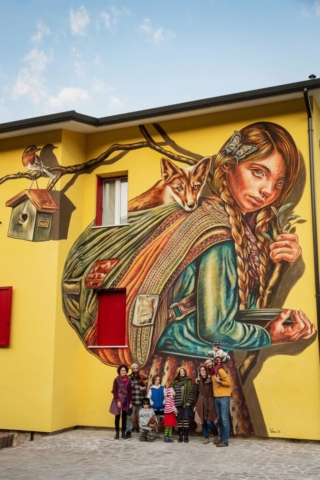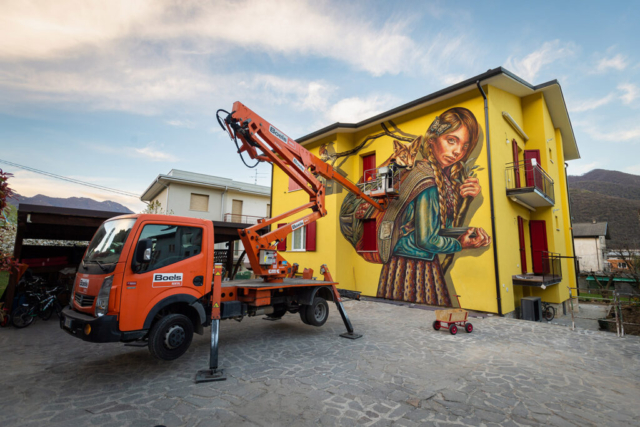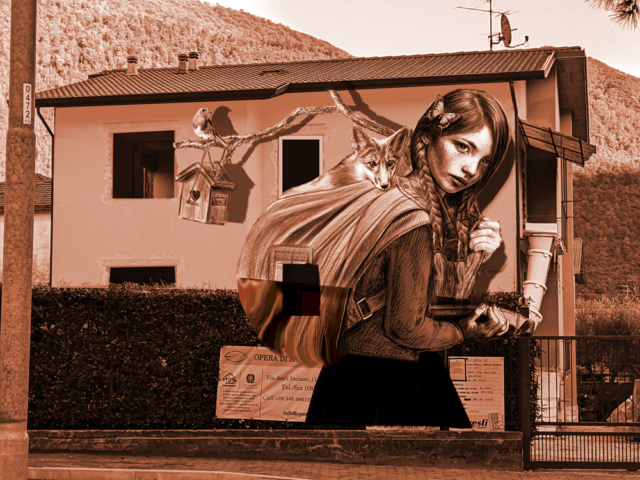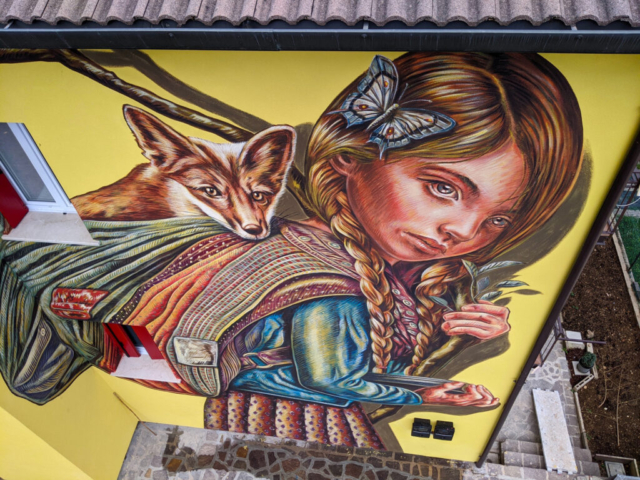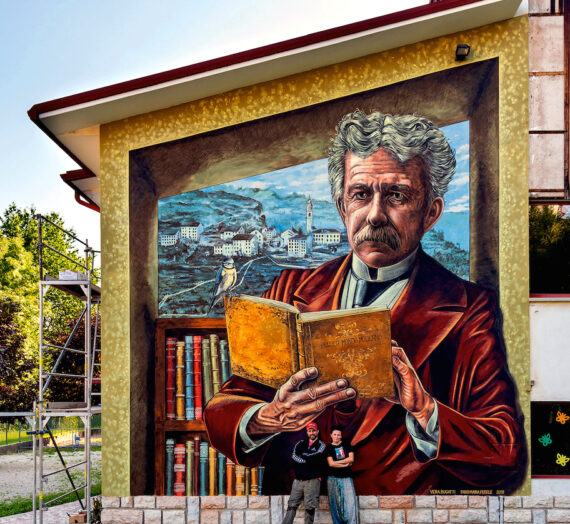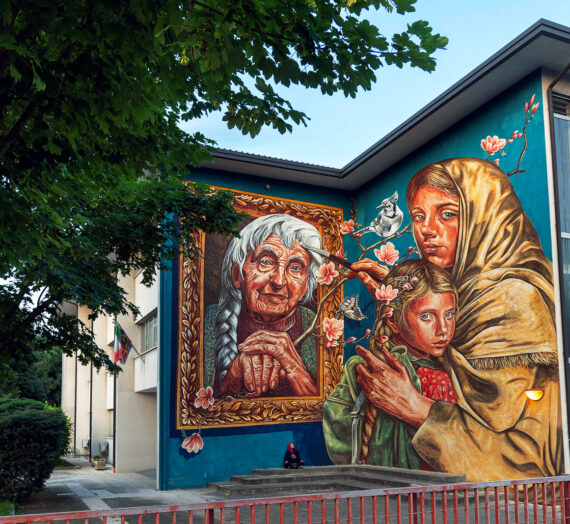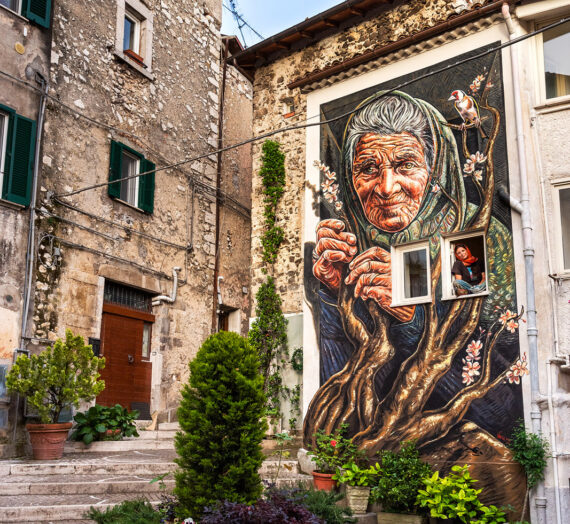La mia ultima opera – Il bagaglio, in cammino ed altri 8 titoli – è nata in terra familiare, a Villa Carcina, nella valle dove sono cresciuta e a pochi chilometri dalle case della mia infanzia (parlo sempre al plurale, le dimore zananesi sono state tre e ora sono alla decima, o più?).
Dopo tanto viaggiare fra un volo e l’altro suona quasi strano lavorare dove capisci (ma parli male, ahimè) il dialetto locale. Essere adottata da due famiglie e far parte per un po’ della loro quotidianità, mangiare tutti insieme, sentire i bambini che raccontano storie, ascoltare diversi punti di vista: è stato un po’ magico.
Vi racconto com’è nato il progetto, il primo su pareti di una casa privata, non legato ad un festival di arte urbana o ad eventi culturali istituzionali. Bisogna tornare indietro di oltre due anni ma ve ne parlo al presente per alleggerire il ritmo narrativo che già, si sa, sono prolissa.
Il 12 gennaio del 2021 ricevo una mail da Roberto, ex collega al Sistema museale e archivistico della Val Trompia. Mi parla di due famiglie (la sua e quella di amici, sono in otto) che hanno comprato una casa insieme con l’idea di condividere più possibile gli spazi, soprattutto esterni, ma anche molti momenti delle loro giornate (i pasti, i giochi, le letture).
L’idea è insolita e mi incuriosisce. In fondo non è niente di strano se si torna indietro di qualche decennio.
Fra i loro sogni ci sarebbe anche quello di commissionarmi un’opera sulla facciata esterna. Gli spiego che normalmente non lavoro per i privati perché creo i miei soggetti su tema libero e in ogni caso con nessuna limitazione sull’interpretazione di eventuali tematiche proposte.
Carta bianca, in pratica. Lui non si scompone e anzi, capisce benissimo cosa intendo. Si consulta coi suoi e alla fine, coraggiosi fino in fondo e consapevoli di voler un pezzo che possa essere realmente ‘mio’, mi dicono che va bene. Ho quindi un invito ufficiale per un the. In quell’occasione vengo conquistata dall’entusiasmo generale e vedo la prima bozza della casa, disegnata dai bambini, gialla con le ante rosse.
Mi raccontano di loro, di ciò che amano, la natura, camminare (insieme, soprattutto, ma anche da soli. Sono tutti scout, nel senso vero del termine), gli animali, la creatività, la condivisione, la solidarietà, i ritmi più lenti.
Nasce quindi la mia bozza monocroma, modificata di recente con l’allargamento del disegno fino a terra a causa della rimozione di una tettoia. Quando la vedono, un mese dopo il nostro incontro, restano sorpresi e (credo) tirano un sospiro di sollievo.
Carta bianca significa tutto, in fondo. Invece lì dentro ci sono io, come sempre, ma anche loro: Roberto e Federica, con i loro figli Daniele, Giovanni e Silvia; Silene e Davide, col piccolo Tommaso.
Il cantiere partirà a breve, mi dicono, ci possiamo già accordare.
Invece i lavori non partono per molto tempo (come tutti i cantieri, in pratica) e poi ci sono ritardi vari. Loro sono dei duri e dopo più di un anno di attesa entrano senza allacciamenti, dandosi da fare il più possibile.
Finché arriva l’inverno del 2022, io sono distrutta fra lavori e cantiere (il mio, stessa trafila) e proviamo a fissare una vera data per la primavera del 2023, il 24 marzo!
La famigerata pioggia tanto agognata arriva come previsto (come sempre quando inizio un pezzo nuovo, vi ricordo che ho fatto diluviare tre giorni a Dubai e piovere a Lanzarote) ma non disturba e anzi, purifica l’aria pungente che scende dal monte Guglielmo.
Non dico a nessuno dove sono ma il colore della casa e qualche soffiata mi porta alcuni visitatori curiosi, amici e parenti. Perfino la mia nonna Modesta, di 95 anni, che si siede sotto la piattaforma e mi guarda dipingere per un’ora. La bambina con la treccia ricambia lo sguardo, lei sa che su quella sedia ci sono le mie radici del cuore (sono un po’ anche le sue, in sostanza).
L’opera si conclude la domenica successiva, dopo una grandinata che schiva le fragole appena piantate.
Quindi? Cosa vuol significare questa ragazzina in cammino, che porta una volpe nella fascia/zaino, e un bastone ricurvo con appesa una casetta di legno sulla quale campeggia un pettirosso?
Lungo la strada della vita trasportiamo costantemente un grosso bagaglio, metafora esistenziale. Si riempie, si svuota. Se pesa troppo da un lato (quanto spazio ha il passato? E il futuro?) ci sbilancia e rischia di farci cadere. Trovare l’equilibrio non è facile, in questo viaggio a tratti impervio. Il bagaglio è multicolore e asimmetrico, contiene oneri e memorie, sensazioni piacevoli e dolore. Ci sono toppe, dignitosamente adiacenti al resto ma ben visibili, e tasche nascoste che si confondono con le trame della tessitura, rappresentano ricordi e sogni, cadute e scelte possibili. Se il fardello è bilanciato ci aiuta nel viaggio e se crescendo diventiamo custodi di ciò che contiene allora contemporaneamente portiamo sulle nostre spalle la responsabilità di un’intera civiltà.
La ragazzina ha uno sguardo maturo e sembra si volti indietro per dire qualcosa (questo è ciò che ha percepito il padre di Federica e lo condivido). Ha mani forti ma con atteggiamenti diversi: la prima afferra e stringe il bastone nodoso con decisione, sente il peso della casetta e del suo ospite e li protegge; la seconda regge invece delicatamente un libro mostrandone il dorso, non lascia capire volutamente di cosa si tratta: la cultura e l’educazione sono unitamente un forziere potente contro l’intolleranza e le disuguaglianze.
La volpe e il pettirosso abitano le nostre montagne, sono simboli di rinascita e di rinnovamento ma soprattutto della necessità di tornare ad un rapporto sano ed empatico con la natura, spesso saccheggiata e deturpata. La volpe viaggia infatti protetta dallo zaino, la porta della casetta di legno è visibilmente troppo piccola per ospitare il pettirosso e il ramo è spoglio se si eccettuano le poche foglie verdi che paiono generate dalla mano della ragazzina.
Riecco la poetica etica e ambientalista, di resistenza, che ritorna spesso nei miei pezzi (pensate a L’Attenzione o a L’Ostinazione).
Gli animali guardano direttamente verso lo spettatore, la fanciulla solo di sbieco, si guarda anche alle spalle, pare abbia uno sguardo su tutto: indubbiamente è lei la custode.
L’iconografia è nata da una riflessione sul ruolo essenziale svolto dai ragazzi di tutto il mondo nelle mobilitazioni a difesa dell’ambiente. Un impegno diventato evidente e oggetto recente di dibattito pubblico. La tutela ambientale è considerata da molti giovani e giovanissimi una delle maggiori priorità così come la lotta alla povertà e alla disuguaglianza.
Tutto è compromesso, forse irrimediabilmente, proviamo a non essere anestetizzati da questa società che ci dice anche cosa desiderare.
L’esperienza di condivisione con queste due famiglie stupende mi lascia un po’ di speranza nel futuro. C’è aria di cambiamento?
Ma quale titolo dare infine all’opera? L’ho chiesto ai magnifici otto:
- L’ora del mondo (Roberto)
- Le toppe e le tappe (Federica)
- Il tempo è ora (Silene)
- Mettiamo le zampe avanti? (Davide)
- Selvaggia (Daniele)
- Portare la furba (Giovanni)
- Volpe volpina (Silvia)
- Silvia o il Pitturo (Tommaso)
Qualcuno mi ha fatto notare che l’idea del peso del bagaglio gli ricordava il romanzo della Tuti dedicato alle portatrici carniche della Prima Guerra Mondiale. Poi sono emerse altre idee legate alla caparbietà della ragazza, alla salvaguardia del pianeta, alla responsabilità di tutti.
E voi che titolo dareste? Sono tutti validi, davvero.
Le fotografie sono come sempre di Andrea Zampatti, che ringrazio per molteplici cose : )
L’opera si trova in Via Canossi 20 a Villa Carcina (BS), di fronte al cimitero comunale.
(And now in English)
My latest work – The baggage, on the way and 8 other titles – was born in a familiar land, in Villa Carcina, in the valley where I grew up and a few kilometers from the houses of my childhood.
After so much traveling between flights, it seems almost strange to work where you understand (but speak badly) the local dialect. Being adopted by two families and being part of their daily lives for a while, eating all together, hearing the children tell stories, listening to different points of view. It was kind of magical.
I’ll tell you how the project was born, the first time on a wall of a private house, not linked to an urban art festival or institutional cultural events. We need to go back more than two years.
On January 12, 2021, I received an email from Roberto, a former colleague at the Val Trompia museum and archive system. He tells me about two families (his and that of friends, there are eight of them) who bought a house together with the idea of sharing spaces as much as possible, especially outdoors, but also many moments of their days (meals, games, the readings).
The idea is unusual and intrigues me. After all, it’s nothing strange if you go back a few decades.
Among their dreams there would also be to commission me a work on the external facade. I explain to him that I don’t normally work for individuals because I create my subjects on a free theme and in any case with no limitation on the interpretation of any proposed themes.
White paper, basically. He doesn’t get upset and indeed, he understands very well what I mean. He consults with the others and in the end, courageous and aware of wanting a piece that can really be ‘mine’, they tell me well, it’s okay. So I have an official invitation for tea. On that occasion I was conquered by the general enthusiasm and I saw the first draft of the house, designed by the children, yellow with red doors.
They tell me about them, about what they love, nature, walking (together, above all, but also alone), animals, creativity, sharing, solidarity, rhythms slower.
Thus my monochrome draft was born, recently modified with the enlargement of the drawing to the ground due to the removal of a canopy. When they see her, a month after our meeting, they are surprised and (I think) breathe a sigh of relief.
Carte blanche means everything, after all. Instead, I’m in there, as always, but also them: Roberto and Federica, with their children Daniele, Giovanni and Silvia; Silene and David, with little Thomas.
The construction site will start shortly, they tell me, we can already agree.
Instead, the works don’t start for a long time (like all construction sites, in practice) and then there are various delays. They are tough and after more than a year of waiting they enter without connections, giving themselves as much as possible.
Until the winter of 2022 arrives, I am destroyed between work and construction site (mine, same process) and we try to set a real date for spring 2023, March 24th!
The infamous longed-for rain arrives as expected (as always when I start a new piece, I remind you that I made it rain for three days in Dubai and rain in Lanzarote) but it does not disturb and indeed, it purifies the pungent air that descends from Mount Guglielmo.
I don’t tell anyone where I am but the color of the house and a few tips bring me some curious visitors, friends and relatives. Even my 95-year-old grandmother Modesta who sits under the platform and watches me paint for an hour. The little girl with the braid returns her gaze, she knows that in that chair there are my roots of the heart (they are also a bit of hers, essentially hers) of hers.
The work ends the following Sunday, after a hailstorm that dodges the newly planted strawberries.
So? What does this little girl on the way mean, carrying a fox in her sash/backpack, and a curved stick with a wooden house hanging on which a robin stands out?
Along the road of life we constantly carry a big baggage, an existential metaphor. It fills up, it empties. If it weighs too much on one side (how much space does the past have? And the future?) it throws us off balance and risks making us fall. Finding the balance is not easy, on this sometimes impervious path. Baggage is multicolored and asymmetrical, it contains burdens and pleasures, memories, pleasant sensations and pain. There are patches, dignifiedly adjacent to the rest but clearly visible, and hidden pockets that blend in with the texture of the weave, representing memories and dreams, falls and possible choices. If the burden is balanced it helps us on the journey and if as we grow we become guardians of what it contains then at the same time we carry the responsibility of an entire civilization on our shoulders.
The girl has a mature look and seems to turn back to say something (this is what Federica’s father perceived and I agree with it). She has strong hands but with different attitudes: the first of hers firmly grips the knotty stick, she feels the weight of the house and of her guest and protects them; the second instead delicately holds a book showing its back, she deliberately does not let us understand what it is about, culture and education are together a powerful chest against intolerance and inequalities.
The fox and the robin inhabit our mountains, they are symbols of rebirth and renewal but above all of the need to return to a healthy relationship with nature, often plundered and disfigured. In fact, the fox travels protected by the backpack, the door of the wooden house is too small for the robin and the branch is bare except for the few green leaves next to the girl’s hand. The animals look directly at the viewer, the girl doesn’t, she has to protect them and be ready. So she is the keeper.
The iconography was born from a reflection on the essential role played by young people from all over the world in mobilizations in defense of the environment. A commitment that has become evident and has recently become the subject of public debate. Environmental protection is considered by many young and very young people to be one of the top priorities, as is the fight against poverty and inequality.
Everything is compromised, perhaps irreparably, let’s try not to be anesthetized by this society which also tells us what to desire. The sharing experience with these two wonderful families leaves me a little hope for the future, is there an air of change?
But what title to finally give to the work? I asked the Magnificent Eight:
– The time of the world (Roberto)
– The patches and stages (Federica)
– The time is now (Silene)
– Shall we put our paws forward? (Davide)
– Wild (Daniele)
– Bring the smart (Giovanni)
– Little fox (Silvia)
– Silvia (Tommaso)
Someone pointed out to me that the idea of the weight of the baggage reminded him of Tuti’s novel dedicated to the Carnic female carriers of the First World War. Then other ideas emerged related to the girl’s stubbornness, to safeguarding the planet, to everyone’s responsibility.
And what title would you give? They are all valid, really.
